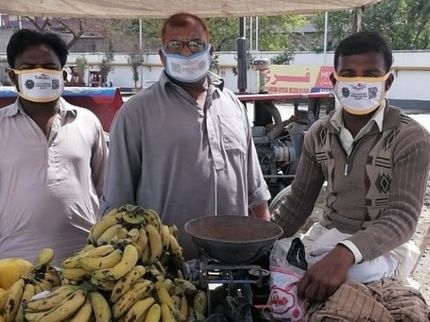Airtight corn sacks help fight hunger during the COVID-19 pandemic
Advertisement
Optimised on-farm grain storage boosts food security in sub-Saharan Africa, as an ETH study in Kenya during the COVID-19 pandemic shows.

Michael Brander / ETH Zürich
As the end of the lean season approaches, things get tricky for many smallholder farmers in sub-Saharan Africa. It’s the time of year between harvests – the last one was a long time ago, but the next one is not yet due. Supplies are running low, diminished not only by consumption but also by pests. In western Kenya, where corn is a major crop stored on the farm where it is grown, about a quarter of the entire harvest ends up spoiled in this way. If the lean season drags on, food prices shoot up and famine becomes a real threat.
It’s clear that optimised crop storage could help improve food security. In a research project spanning several years, ETH Zurich, the University of Zurich and the Kenyan research institute icipe are currently investigating how the application of new technology can help change the situation. As part of the study, in late 2019 several thousand smallholder farmers were given airtight storage sacks designed to prevent fungal infestation of their crops. They also received training by the research team. A control group continued to store their corn in conventional polypropylene sacks. What sets the study apart is the survey method. Since mobile phone use is very high in Kenya, as is the case in many African countries, the researchers use text messaging to survey the farmers about their food situation at frequent, regular intervals.
Greater resilience to shock caused by COVID-19
Following the outbreak of the COVID-19 pandemic, food insecurity was lower in the farming villages that received the upgraded technology than in the control group. After all, the virus and associated restrictions created an economic shock for sub-Saharan Africa following the government-imposed closure of markets, restrictions on people’s mobility and suspension of free meals for schoolchildren.
In their preliminary study published in the journal Global Food Security, the researchers show that consistent use of hermetically sealed storage sacks would have significantly improved rural populations’ resilience to crises. According to an extrapolation of the survey results, of the 1.6 million people living in the Kenyan province studied, some 600,000 people were already facing food insecurity prior to the outbreak of the pandemic. The virus pushed a further 120,000 people into this situation. If farmers throughout the province had used hermetically sealed sacks to store all their yields, the number of people facing food insecurity would have actually dropped by 70,000.
The Swiss Agency for Development and Cooperation (SDC) and ETH for Development (ETH4D) are among the agencies supporting the research team. Thomas Bernauer, ETH Professor of Political Science, is involved in the project and explains that research in the fight against hunger has so far focused primarily on production, in other words on increasing crop yields. However, the study in Kenya shows that there is also great potential to make a difference in the post-harvest period. Another finding, he continues, is that there are also low-cost technologies that greatly promote food security, even in extreme conditions such as those that followed the outbreak of the pandemic.
Much more effective than financial aid
Including the cost of training, the airtight storage sacks cost only about 20 US dollars per household – considerably less than direct financial aid. This is shown by a comparison with another study from Kenya in which a random selection of smallholder households received a lump sum of 500 US dollars. This financial support reduced the likelihood that they would face food insecurity by about 5 to 10 percent – similar results to the hermetic bag recipients, but at much higher cost.
Besides epidemiological risks, which in recent times have included Ebola in addition to COVID-19, climate change also threatens food security in sub-Saharan Africa. The ongoing study in Kenya shows that households equipped with better technology endure considerably lower post-harvest losses and are thus more resilient to climate-induced food crises.
So why does it take an ETH project to get Kenyan farmers to start storing their corn in airtight sacks? Bernauer believes that to make even a very small step forward with new technology, there would first have to be an adaption process, possibly through information campaigns or the provision of initial funding. That’s not something this research project covers, but the UN’s Food and Agriculture Organization (FAO) and its World Food Programme have shown a keen interest in the results.
Original publication
Other news from the department science
Most read news
More news from our other portals
See the theme worlds for related content
Topic world Food safety
Food safety is at the heart of the food and beverage industry. It ensures that the food we eat every day is not only nutritious, but also free of harmful contaminants. From field to plate, the industry monitors and regulates every step of the process with strict quality controls, advanced testing methods and continuous research.

Topic world Food safety
Food safety is at the heart of the food and beverage industry. It ensures that the food we eat every day is not only nutritious, but also free of harmful contaminants. From field to plate, the industry monitors and regulates every step of the process with strict quality controls, advanced testing methods and continuous research.




























































